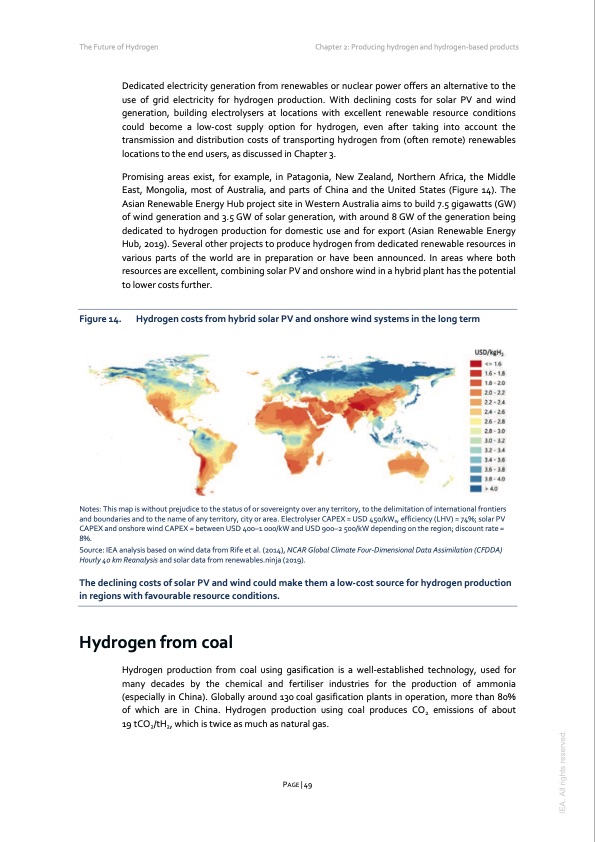
PDF Publication Title:
Text from PDF Page: 049
The Future of Hydrogen Chapter 2: Producing hydrogen and hydrogen-based products Figure 14. Dedicated electricity generation from renewables or nuclear power offers an alternative to the use of grid electricity for hydrogen production. With declining costs for solar PV and wind generation, building electrolysers at locations with excellent renewable resource conditions could become a low-cost supply option for hydrogen, even after taking into account the transmission and distribution costs of transporting hydrogen from (often remote) renewables locations to the end users, as discussed in Chapter 3. Promising areas exist, for example, in Patagonia, New Zealand, Northern Africa, the Middle East, Mongolia, most of Australia, and parts of China and the United States (Figure 14). The Asian Renewable Energy Hub project site in Western Australia aims to build 7.5 gigawatts (GW) of wind generation and 3.5 GW of solar generation, with around 8 GW of the generation being dedicated to hydrogen production for domestic use and for export (Asian Renewable Energy Hub, 2019). Several other projects to produce hydrogen from dedicated renewable resources in various parts of the world are in preparation or have been announced. In areas where both resources are excellent, combining solar PV and onshore wind in a hybrid plant has the potential to lower costs further. Hydrogen costs from hybrid solar PV and onshore wind systems in the long term Notes: This map is without prejudice to the status of or sovereignty over any territory, to the delimitation of international frontiers and boundaries and to the name of any territory, city or area. Electrolyser CAPEX = USD 450/kWe, efficiency (LHV) = 74%; solar PV CAPEX and onshore wind CAPEX = between USD 400–1 000/kW and USD 900–2 500/kW depending on the region; discount rate = 8%. Source: IEA analysis based on wind data from Rife et al. (2014), NCAR Global Climate Four-Dimensional Data Assimilation (CFDDA) Hourly 40 km Reanalysis and solar data from renewables.ninja (2019). The declining costs of solar PV and wind could make them a low-cost source for hydrogen production in regions with favourable resource conditions. Hydrogen from coal Hydrogen production from coal using gasification is a well-established technology, used for many decades by the chemical and fertiliser industries for the production of ammonia (especially in China). Globally around 130 coal gasification plants in operation, more than 80% of which are in China. Hydrogen production using coal produces CO2 emissions of about 19 tCO2/tH2, which is twice as much as natural gas. PAGE | 49 IEA. All rights reserved.PDF Image | The Future of Hydrogen 2019

PDF Search Title:
The Future of Hydrogen 2019Original File Name Searched:
the_future_of_hydrogen.pdfDIY PDF Search: Google It | Yahoo | Bing
NFT (Non Fungible Token): Buy our tech, design, development or system NFT and become part of our tech NFT network... More Info
IT XR Project Redstone NFT Available for Sale: NFT for high tech turbine design with one part 3D printed counter-rotating energy turbine. Be part of the future with this NFT. Can be bought and sold but only one design NFT exists. Royalties go to the developer (Infinity) to keep enhancing design and applications... More Info
Infinity Turbine IT XR Project Redstone Design: NFT for sale... NFT for high tech turbine design with one part 3D printed counter-rotating energy turbine. Includes all rights to this turbine design, including license for Fluid Handling Block I and II for the turbine assembly and housing. The NFT includes the blueprints (cad/cam), revenue streams, and all future development of the IT XR Project Redstone... More Info
Infinity Turbine ROT Radial Outflow Turbine 24 Design and Worldwide Rights: NFT for sale... NFT for the ROT 24 energy turbine. Be part of the future with this NFT. This design can be bought and sold but only one design NFT exists. You may manufacture the unit, or get the revenues from its sale from Infinity Turbine. Royalties go to the developer (Infinity) to keep enhancing design and applications... More Info
Infinity Supercritical CO2 10 Liter Extractor Design and Worldwide Rights: The Infinity Supercritical 10L CO2 extractor is for botanical oil extraction, which is rich in terpenes and can produce shelf ready full spectrum oil. With over 5 years of development, this industry leader mature extractor machine has been sold since 2015 and is part of many profitable businesses. The process can also be used for electrowinning, e-waste recycling, and lithium battery recycling, gold mining electronic wastes, precious metals. CO2 can also be used in a reverse fuel cell with nafion to make a gas-to-liquids fuel, such as methanol, ethanol and butanol or ethylene. Supercritical CO2 has also been used for treating nafion to make it more effective catalyst. This NFT is for the purchase of worldwide rights which includes the design. More Info
NFT (Non Fungible Token): Buy our tech, design, development or system NFT and become part of our tech NFT network... More Info
Infinity Turbine Products: Special for this month, any plans are $10,000 for complete Cad/Cam blueprints. License is for one build. Try before you buy a production license. May pay by Bitcoin or other Crypto. Products Page... More Info
| CONTACT TEL: 608-238-6001 Email: greg@infinityturbine.com | RSS | AMP |